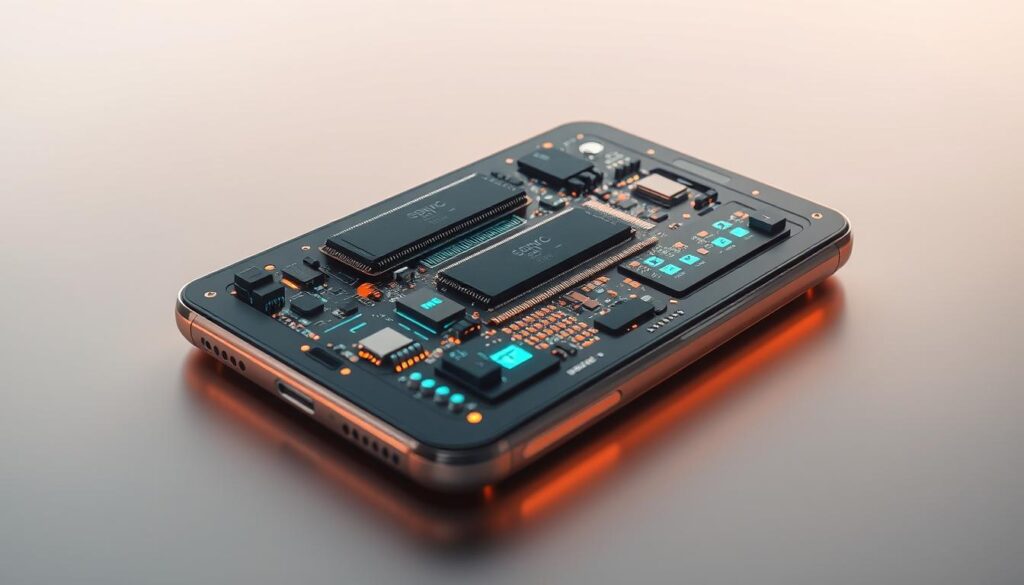Ever wondered why your Android app slows down or crashes, even with enough resources? Memory fragmentation is often the cause. It’s a big problem for Android performance. We’ll explore ways to tackle this issue in procedural environments on Android.
By learning about effective memory management, you can boost your app’s performance. This is especially important in mobile environments where resources are limited. Knowing these techniques is key to avoiding performance issues and giving users a better experience.
Understanding Memory Fragmentation in Android
Memory fragmentation is a big problem in Android Memory Management. It happens when free memory is split into many small, non-contiguous blocks. This makes it hard for apps to run smoothly because the system can’t find enough memory to allocate.
In Android, where devices vary a lot, managing memory well is key. As apps need more memory, fragmentation gets worse. This slows down not just one app but the whole system. Fixing memory fragmentation is vital for apps to work well on different Android devices.

The Importance of Memory Management in Mobile Devices
Mobile devices like smartphones and tablets need good memory management. This is because they have limited resources. It’s key to make sure apps run smoothly.
Without proper memory management, apps can freeze or crash. This makes users unhappy and can harm the app’s reputation. Users want apps to work fast and without delay.
Good memory management also helps save battery life. It makes sure apps use resources well, saving energy. Developers must understand this to make apps that work well and last long.

What Causes Memory Fragmentation?
Memory fragmentation happens when apps don’t use memory well. It’s often because developers don’t plan memory use correctly. This leads to wasted space in memory.
Creating lots of objects also causes problems. Each object takes up space in memory. If these objects don’t last long, it makes memory harder to manage. This slows down apps.
| Cause | Description | Impact on Memory |
|---|---|---|
| Inadequate Memory Allocation | Poorly designed allocation strategies that don’t match usage patterns. | Leads to inefficient memory use, creating gaps. |
| Frequent Object Creation | High turnover of short-lived objects increases fragmentation. | Produces multiple small memory blocks, complicating reuse. |
| Garbage Collection Inefficiency | Suboptimal performance of the garbage collector failing to reclaim memory. | Prevents reallocation of memory and exacerbates fragmentation. |
| Memory Leaks | Unreleased references preventing memory from being freed. | Cumulative effects lead to significant loss of memory availability. |
Memory leaks make fragmentation worse. When apps hold onto objects they don’t need, memory can’t be freed. This makes apps run slower. It’s key for developers to manage memory well to avoid these problems.
How Android Handles Memory Allocation
Android uses smart strategies for memory allocation through ART and the Dalvik virtual machine. When an app needs memory, the system gives it chunks from the heap. This ensures resources are used well. The process involves Memory Management Techniques that control how memory is split, used, and freed.
Memory allocation starts when an app asks for memory. The Android Runtime (ART) decides how much memory an app can use. It looks at the app’s needs and the device’s limits. Techniques like paging and memory-mapping help manage memory well, improving app performance and stability.
Knowing how Android Memory Allocation works is key for app development. Developers must think about memory use and fragmentation. Good memory management makes apps run better and gives users a smoother experience.
| Memory Management Techniques | Description | Benefits |
|---|---|---|
| Heap Allocation | Dynamic memory allocation from the heap for objects | Flexible memory usage, reducing fixed memory allocation overhead |
| Paging | Breaking memory into smaller pages managed by the system | Efficient use of memory and reduced fragmentation |
| Memory-Mapping (mmapping) | Mapping files or devices into memory for direct access | Faster data access and simplified data management |
Garbage Collection Mechanism in Android
The garbage collection mechanism is key to Memory Management in Android. It makes sure unused memory is freed up efficiently. This process mainly uses generational garbage collection.
Generational garbage collection sorts memory into different groups based on how long objects last. New objects go to the younger generation, where they are quickly cleaned up. As objects get older and less used, they move to older generations. Here, they are cleaned up less often.
Object Reclamation happens in stages, focusing on different generations. The young generation gets cleaned up more often. This is because many new objects don’t last long. This approach helps manage memory well and keeps apps running smoothly.
However, when garbage collection happens, it can slow down apps. This is especially true if it happens during busy tasks. It can cause noticeable delays.
Knowing when and how garbage collection happens helps developers plan better. They can make apps more efficient and responsive. By reducing object creation and optimizing how objects are allocated, developers can lessen the impact of garbage collection.
Reducing Memory Fragmentation in Procedural Environments
Memory fragmentation is a big problem in procedural environments. It happens when you need to change memory often. Developers must understand this to make apps better and faster.
As apps get more complex, so does memory fragmentation. This can make apps use more resources than they need to.
Overview of Fragmentation Scenarios
In Android procedural programming, fragmentation happens when you create and delete objects. Each object takes up some memory. When you delete objects, you get small gaps in memory.
These gaps are called fragmentation. Bad coding habits, like asking for too much memory, make it worse. To fix this, developers use tricks like pooling objects or better memory management.
Impact on Performance
Fragmented memory slows down apps a lot. It’s hard for the system to find free memory for new objects. This makes apps run slower and feel less responsive.
Users notice this as lag, slow frame rates, and stiff interactions. To improve this, developers use Android Optimization. This makes apps run smoothly, even when they’re busy.
Strategies for Effective Memory Management
In the world of mobile app development, managing memory well is key for a smooth user experience. Developers use many techniques to make apps run better. They focus on reducing unnecessary objects and using Lazy Loading for data.
Minimizing Object Creation
Reducing object creation is a big part of memory management. Developers use strategies like object pooling. This method reuses objects instead of making new ones.
Object pooling cuts down on memory use and makes apps faster. It helps the garbage collector work less, giving users a better experience.
Implementing Lazy Loading Techniques
Lazy Loading is another smart way to manage memory. It loads data only when it’s needed, avoiding memory problems. By loading resources bit by bit, apps become more responsive.
Lazy Loading saves memory and speeds up apps. It’s especially important in places where memory is limited.
Optimizing Data Structures and Algorithms
Choosing the right data structures is key to saving memory in apps. Using memory-efficient containers that fit your data needs can cut down on memory waste. For example, using an array instead of a linked list saves memory when dealing with fixed-size data.
Data Structures Optimization helps use resources better. Hash tables, for instance, speed up data access without wasting memory. When making algorithms, think about how they use time and space. Algorithms that use less space can make apps run smoother.
Using the best methods in algorithm design, like iterative over recursive, saves memory and boosts speed. By making smart choices in data structures and algorithms, developers can build efficient systems. These systems handle loads well and use resources wisely.
Using Bitmap Management Techniques
Handling Android Images well is key, as big bitmap files use a lot of memory. Bitmap Management helps by using different methods to save memory in Android apps. Without proper management, big images can cause apps to crash, leading to poor performance.
One good way to save memory is to resize images before they’re loaded. By making images smaller, they use less memory. This is especially helpful for devices with less power.
Using bitmap caching is also smart. It stores images that are used a lot, so they can be quickly accessed. This cuts down on memory use and makes apps run faster.
Also, compressing images helps save memory. By making images smaller, they use less space without losing quality. This keeps apps running smoothly and saves memory.
By using these bitmap management methods, developers make apps use less memory. This makes apps run better and gives users a better experience. It helps apps work well on all kinds of devices.
The Role of Shared Memory in Android
Shared Memory Android is key in making apps work better together. It lets different apps share the same memory space. This cuts down on memory use, making apps run smoother, especially when resources are tight.
Memory mapping, or mmapping, is a way to share memory. It lets apps access data directly from memory. This makes apps more efficient and improves how they share resources.
For developers, knowing about shared memory is vital. It helps them make apps that use resources well and run smoothly. This leads to a better experience for users.
Stress Testing Your Application for Memory Constraints
Stress testing Android apps is key to making sure they work well, even when memory is tight. Developers use these tests to see how apps handle low memory. This helps find problems like memory leaks and crashes that happen when apps use too much memory.
Tools like stressapptest give valuable info on how apps perform with little memory. Running these tests shows how well apps manage memory and adapt to changing needs. This helps developers make their apps work better on more devices.
Stress testing is crucial for spotting performance issues that might not show up in regular tests. It shows the need for thorough testing to make apps that can handle different memory situations well. This leads to apps that work smoothly, no matter the device.
Best Practices for Memory Allocation and Deallocation
Managing memory well is key to making apps run smoothly on Android devices. Using Best Practices Memory Management helps keep allocation and deallocation efficient. This leads to better Memory Efficiency. One good way is to use memory pools.
Memory pools reduce overhead by reusing memory blocks. They keep a supply of ready-to-use memory.
Handling errors when memory can’t be allocated is also crucial. This prevents apps from crashing and keeps users happy. Alerting users or logging errors when allocations fail is important.
Dealing with memory leaks by timely deallocation is vital. Not freeing up memory causes fragmentation, hurting performance. Developers should deallocate objects when they’re no longer needed.
This keeps memory efficient and prevents apps from slowing down.
In short, following these best practices is vital for Android apps. Focusing on memory pools, error handling, and deallocation makes apps more efficient and stable.
Conclusion
Effective memory management is key for better Android app performance. We’ve looked at ways to cut down memory waste. This includes reducing object creation and optimizing data structures.
Bitmap management is also crucial. These steps help make apps run faster and feel smoother to users.
Mobile tech keeps getting better, but it also brings new challenges. Developers must stay up-to-date and adapt quickly. The tips in this article show how important it is to keep improving.
By focusing on memory management, apps can run better. This means faster and more enjoyable user experiences. Adopting these strategies helps developers make apps that stand out in a crowded market.
FAQ
What is memory fragmentation in the context of Android applications?
Memory fragmentation happens when memory is not used well. Free memory is split into small, non-contiguous blocks. This can slow down apps, leading to more memory use and crashes.
How does memory fragmentation affect app performance on Android devices?
It slows down app processing, making apps less responsive. If not fixed, it can cause apps to freeze or crash. This makes users unhappy.
What are some common causes of memory fragmentation in Android applications?
Memory fragmentation is caused by poor memory allocation, creating many objects, and inefficient garbage collection. Memory leaks also play a role, making memory hard to manage.
How does Android handle memory allocation for applications?
Android uses ART and Dalvik for memory allocation. When an app needs memory, the system gives it parts of the heap. It uses paging and memory mapping to manage resources well.
What is the role of garbage collection in Android’s memory management?
Garbage collection is key for freeing up unused memory. It sorts memory into generations based on object age. This helps reduce fragmentation and improve performance, but can interrupt apps if not timed right.
What strategies can developers use to reduce memory fragmentation in their apps?
Developers can reduce fragmentation by using object pooling and lazy loading. Choosing the right data structures also helps tailor memory use for specific needs.
How can bitmap management techniques help optimize memory in Android apps?
Bitmap management, like resizing and caching, reduces memory used by large images. These techniques prevent out-of-memory errors, improving app performance.
What is the significance of shared memory in Android’s RAM management?
Shared memory lets multiple processes use the same memory space, saving memory. Memory mapping helps with this, improving memory management and app performance.
Why is stress testing important for memory management in Android applications?
Stress testing under low-memory conditions finds memory leaks and fragmentation. It helps developers improve memory management, making apps more stable and performant.
What best practices should be followed for memory allocation and deallocation in Android?
Use memory pools wisely, handle allocation errors well, and deallocate objects on time to avoid leaks. These practices keep apps stable and fast.




